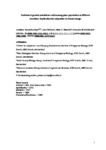Variation in growth and defence traits among plant populations at different elevations: Implications for adaptation to climate change
| dc.contributor.author | Buckley, James | |
| dc.contributor.author | Widmer, A | |
| dc.contributor.author | Mescher, MC | |
| dc.contributor.author | De Moraes, CM | |
| dc.date.accessioned | 2020-09-15T08:11:15Z | |
| dc.date.available | 2020-09-15T08:11:15Z | |
| dc.date.issued | 2019-09 | |
| dc.identifier.issn | 0022-0477 | |
| dc.identifier.issn | 1365-2745 | |
| dc.identifier.uri | http://hdl.handle.net/10026.1/16270 | |
| dc.description.abstract |
Alpine plants occurring at high elevation are vulnerable to ongoing climate change, yet relatively little is known about the potential for high-elevation species to adapt to changing environmental conditions. In particular, the extent to which high-elevation plants will be able to resist predicted increases in the intensity of biotic interactions, such as herbivory, remains unclear. Species distributed across broad elevational ranges provide an opportunity to investigate evolutionary mechanisms and traits involved in adaptation to varying abiotic and biotic environments. This study focused on the perennial alpine plant Arabis alpina and combined field surveys and climate chamber experiments to test for intraspecific genetic divergence in traits related to growth and defence against herbivores. We screened multiple populations from low, intermediate and high elevations across a broad geographic area, characterising differences in growth form, leaf structural traits, palatability for herbivores and defensive chemistry. We then quantified the proportion of variation explained by elevation and population-level effects. Our results document within-species genetic divergence in multiple traits relevant for adaptation to the different abiotic and biotic pressures experienced at low and high elevations. Rates of herbivore damage declined with increasing elevation in the field, but plants from high- and intermediate-elevation populations were generally more palatable for specialist herbivores than those from low-elevation populations in feeding assays. Elevational clines were also observed in several glucosinolate defence compounds, and leaf herbivory more strongly induced glucosinolates in plants from high-elevation populations than in those from low-elevation populations. Leaf trichome density and growth form also diverged among populations contributing to growth–defence phenotypes associated with different elevations. However, populations from similar elevations often differed significantly in both growth- and defence-related traits, with trait variation often better explained by population-level effects than by elevation alone. Synthesis. Arabis alpina exhibits patterns of genetic variation in growth and defence traits consistent with adaptation to different elevations. However, populations from similar elevations also diverge in many of these ecologically relevant traits. Together, the extent of the observed trait variation suggests that this alpine species has considerable potential to adapt to a changing biotic environment. | |
| dc.format.extent | 2478-2492 | |
| dc.language | en | |
| dc.language.iso | en | |
| dc.publisher | Wiley | |
| dc.subject | alpine | |
| dc.subject | Arabis alpina | |
| dc.subject | defence | |
| dc.subject | elevation | |
| dc.subject | environmental change | |
| dc.subject | glucosinolate | |
| dc.subject | growth | |
| dc.subject | herbivore | |
| dc.title | Variation in growth and defence traits among plant populations at different elevations: Implications for adaptation to climate change | |
| dc.type | journal-article | |
| dc.type | Journal Article | |
| plymouth.author-url | https://www.webofscience.com/api/gateway?GWVersion=2&SrcApp=PARTNER_APP&SrcAuth=LinksAMR&KeyUT=WOS:000484311000035&DestLinkType=FullRecord&DestApp=ALL_WOS&UsrCustomerID=11bb513d99f797142bcfeffcc58ea008 | |
| plymouth.issue | 5 | |
| plymouth.volume | 107 | |
| plymouth.publication-status | Published | |
| plymouth.journal | Journal of Ecology | |
| dc.identifier.doi | 10.1111/1365-2745.13171 | |
| plymouth.organisational-group | /Plymouth | |
| plymouth.organisational-group | /Plymouth/Faculty of Science and Engineering | |
| plymouth.organisational-group | /Plymouth/Faculty of Science and Engineering/School of Biological and Marine Sciences | |
| plymouth.organisational-group | /Plymouth/REF 2021 Researchers by UoA | |
| plymouth.organisational-group | /Plymouth/REF 2021 Researchers by UoA/UoA06 Agriculture, Veterinary and Food Science | |
| plymouth.organisational-group | /Plymouth/REF 2021 Researchers by UoA/UoA06 Agriculture, Veterinary and Food Science/UoA06 Agriculture, Veterinary and Food Science MANUAL | |
| plymouth.organisational-group | /Plymouth/Users by role | |
| plymouth.organisational-group | /Plymouth/Users by role/Academics | |
| dcterms.dateAccepted | 2019-03-12 | |
| dc.rights.embargodate | 2023-8-9 | |
| dc.identifier.eissn | 1365-2745 | |
| dc.rights.embargoperiod | Not known | |
| rioxxterms.versionofrecord | 10.1111/1365-2745.13171 | |
| rioxxterms.licenseref.uri | http://www.rioxx.net/licenses/all-rights-reserved | |
| rioxxterms.type | Journal Article/Review |


